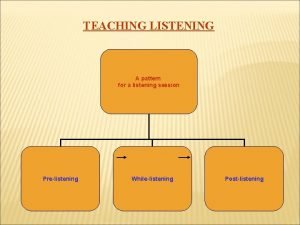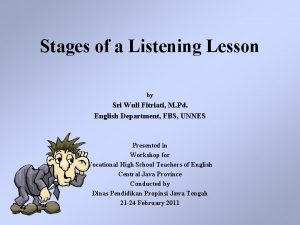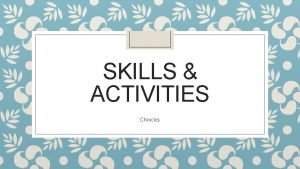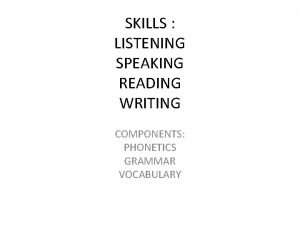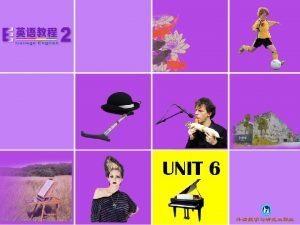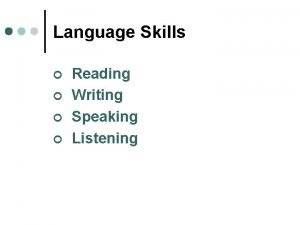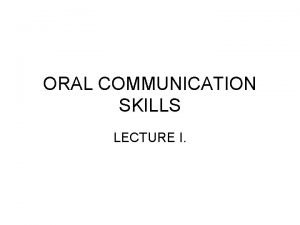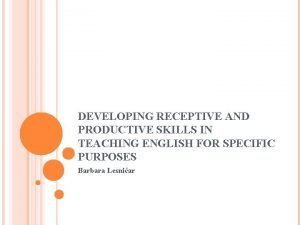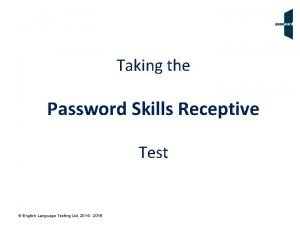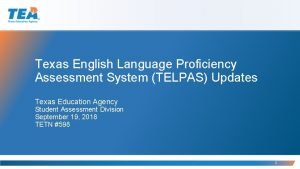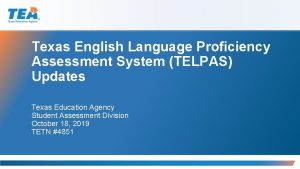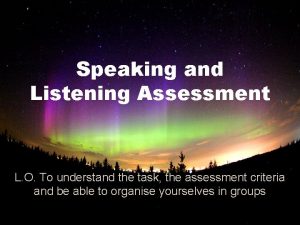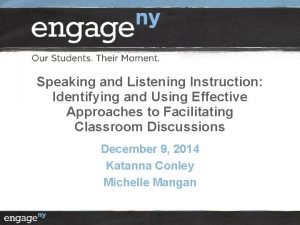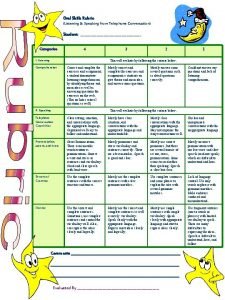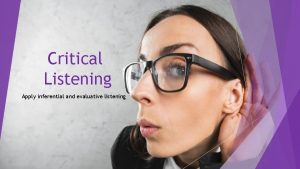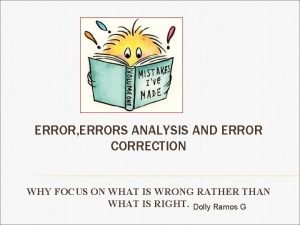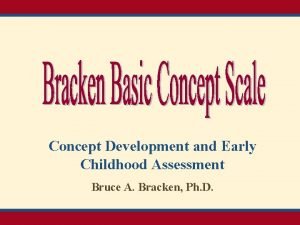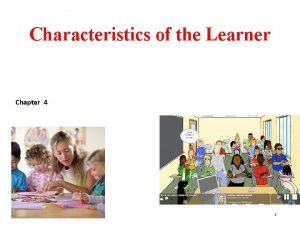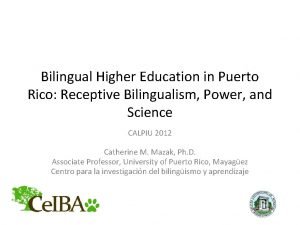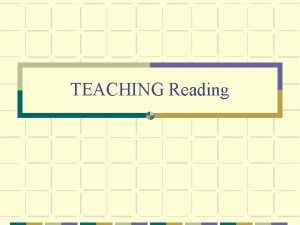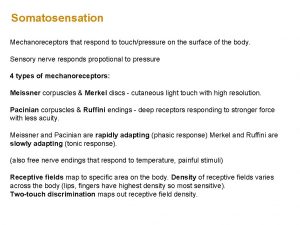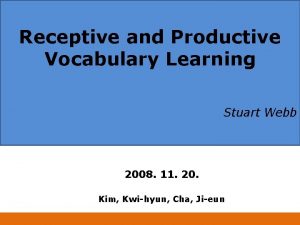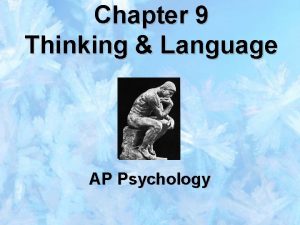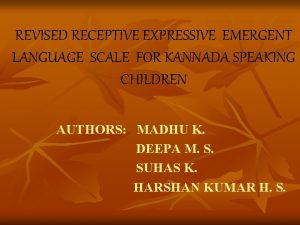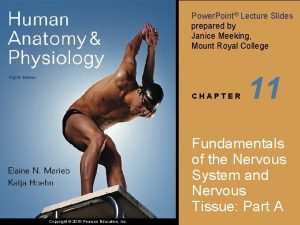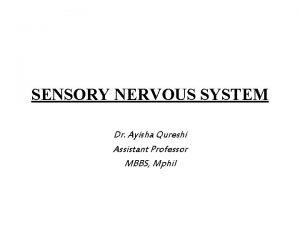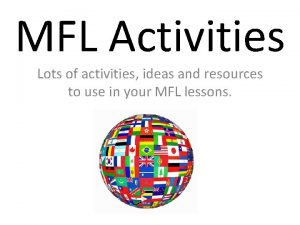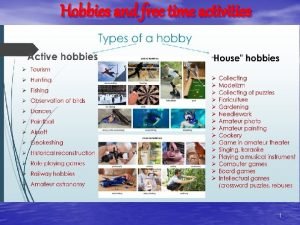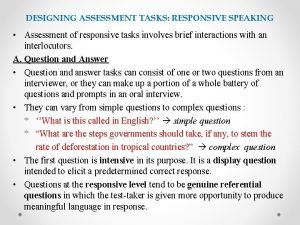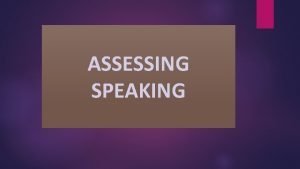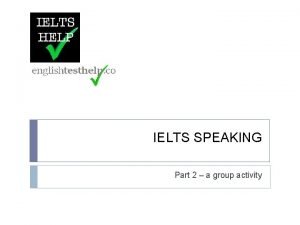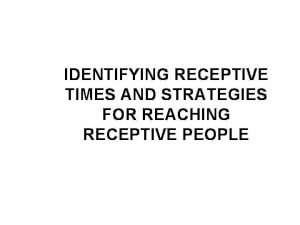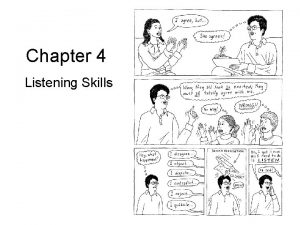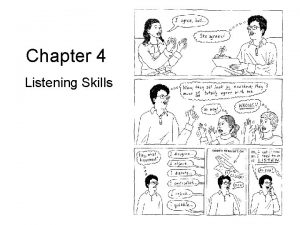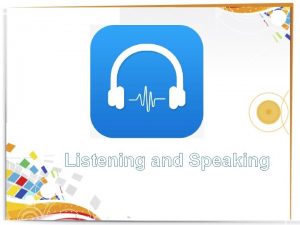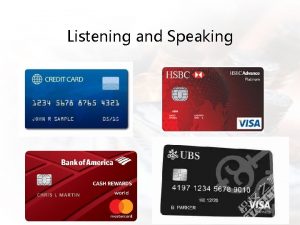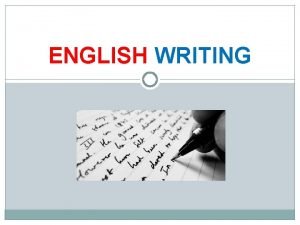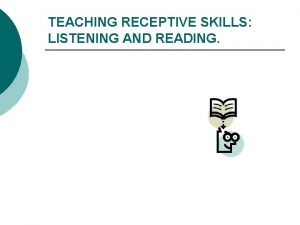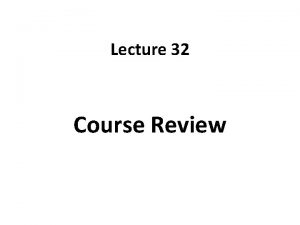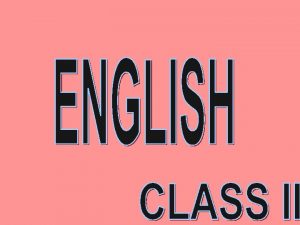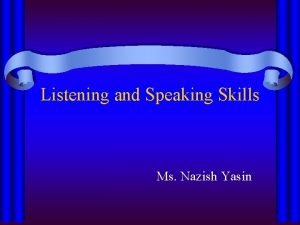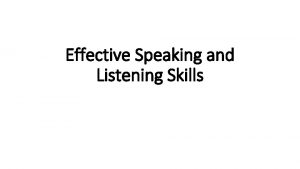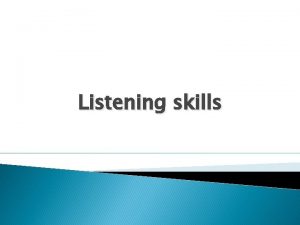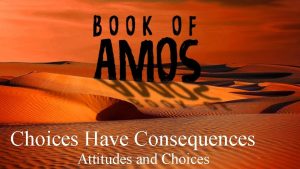SKILLS ACTIVITIES Choices Skills Grammar Listening Speaking Receptive









































- Slides: 41

SKILLS & ACTIVITIES Choices

Skills + Grammar ◦ Listening ◦ Speaking Receptive Skills Productive Skills ◦ Reading Listening Speaking ◦ Writing Reading Writing ◦ Grammar

Past Lesson Flow Suggestions In the past many programs separated classes by skill (Reading, Writing, Listening, Speaking) Nowadays, most textbooks, and teacher take a more integrated approach.

Productive Skills & Grammar: PPP controlled, less-controlled, free ◦ Present/ set the context (situation) ◦ Present the target language ◦ Students drill the target language through repetition activities ◦ Students do a less-controlled activity where they have a language guideline but may also use creatively use the language ◦ Students do a free activity in which they must naturally use the new target language for a specific purpose (without needing to reference it). ◦ Teacher gives feedback to learners highlighting any inaccuracies or issues

Receptive: Pre-While-Post (Task Feedback Cycle) ◦ Lead-in (Setting the context/ background information) ◦ Pre-teach key vocabulary/ grammatical structures ◦ 1 st Listen/ Read – focus on general understanding ◦ 2 nd Listen/ Read – focus on details ◦ Post-Listening discussion – Addressing problems/ questions ◦ Productive Activity – Speaking or writing activity that connected to the key topic or aspects of what they listened to.

WELL BALANCED COURSES The 4 Strands

New Important Features Language focused learning 25% Fluency development 25% Meaning focused input 25% Meaning focused output 25%

Language focused learning ◦ Learning through deliberate attention to language items and language features ◦ Learning through attention to the sounds and spelling of the language, through direct vocabulary study, through grammar exercises and explanation, and through deliberate attention to discourse features.

Meaning-focused input ◦ Learning through listening and reading where the learners’ attention is on the ideas and messages conveyed by the language.

Meaning-focused output ◦ Learning through speaking and writing where the learners’ attention is on conveying ideas and messages to another person

Fluency development ◦ Developing fluent use of known language items and features over the four skills of listening, speaking, reading and writing ◦ Key point: becoming fluent with what is already known.

APPLYING THE 4 STRANDS Critical Thinking and Application

Productive Skills & Grammar: PPP controlled, less-controlled, free ◦ Present/ set the context (situation) ◦ Present the target language ◦ Students drill the target language through repetition activities ◦ Students do a less-controlled activity where they have a language guideline but may also use creatively use the language ◦ Students do a free activity in which they must naturally use the new target language for a specific purpose (without needing to reference it). ◦ Teacher gives feedback to learners highlighting any inaccuracies or issues

Receptive: Pre-While-Post (Task Feedback Cycle) ◦ Lead-in (Setting the context/ background information) ◦ Pre-teach key vocabulary/ grammatical structures ◦ 1 st Listen/ Read – focus on general understanding ◦ 2 nd Listen/ Read – focus on details ◦ Post-Listening discussion – Addressing problems/ questions ◦ Productive Activity – Speaking or writing activity that connected to the key topic or aspects of what they listened to.

Key Points ◦ When creating materials/ textbooks it is important to consider the learners aims and distribute the focus on the 4 strands to meet their aims. ◦ For general development in general English classes the strands should be relatively balanced over the course of a week. ◦ There is currently a lack of focus on MFO and FD and an over focus on LFL and MFI ◦ This has led/ and continues to lead to a lack of productive skill proficiency

READING, LISTENING, SPEAKING, WRITING Activities

LISTENING & READING Receptive

SELECTING A SUITABLE TEXT

Levels of Difficulty ◦ Independent - Easy ◦ Should be able to read alone and comprehend 90% without any help ◦ Instructional - Challenging ◦ The learner understands most of the content but feels the needs help with new words they do not know and comprehension. ◦ They should be able to comprehend at least 75%. ◦ The material should be challenging but not too difficult. ◦ Frustration – Too difficult ◦ This level should be avoided ◦ Word recognition presents such difficulty that adequate comprehension is impossible. ◦ Can comprehend 50% or less ◦ Warning signs: looks of confusion, anger, heavy breathing, crying

ASSESSING STUDENT LEVEL


The Framework ◦ Basic ◦ A 1 ◦ A 2 ◦ Independent ◦ B 1 ◦ B 2 ◦ Proficient ◦ C 1 ◦ C 2

Self-assessment

ASSESSING CONTENT LEVEL

Sample content ◦ Matthew and Jimin saw a strange art show down the street. They were curious. They went inside. The hall had several rooms. They went into the first room. They saw colorful cushions on the benches. The cushions looked beautiful. They were made of plastic bags. Matthew and Jimin went to the next room. There were many pretty lamps. In the center of the room, an artist was explaining her artworks. She was surrounded by many people. Matthew and Jimin went to her. ◦ Students are likely to be more motivated when they have a high expectancy of success in completing the task and when they value the outcome. This principle basically means that students are more likely to do what they expect to accomplish successfully and avoid tasks that they feel they may not be able to do successfully. But this alone is not enough. They also take the value of the tasks into consideration. Thus, students’ expectancy of success and the intrinsic value of the task influence students’ decision to do or avoid the tasks.

Assessing Reading Content Level ◦ https: //www. lexile. com/analyzer/ ◦ https: //lexile. com/educators/measuring-growth-with-lexile/lexile-measures-grade-equivalents/ 4 5 6 7 8 9 10 11 12 Uni

Flesch-Kincaid (MS Word) ◦ Highlight text – Hit F 7 ◦ Based on contexts with predominantly fluent speakers of English ◦ Reading Ease Higher score = easier (Max 120) ◦ ◦ Lower score = more difficult 100 – 90 can be easily understood by an average 11 -year-old student. 60 – 70 can be easily understood by 13 – 15 -year-old students. 30 – 0 is best understood by university graduates. ◦ Grade Level ◦ The score indicates the grade level for which the text is appropriate ◦ The score also means the number of years of education required to understand the text. ◦ A score of 8. 3 indicates that the text can be understood by a typical 8 th grader, or someone with 8 years of education.

CAUTION: Readability Tests Readability tests cannot tell you anything about several important factors which affect readability. For example: Readability formulas are based on measuring words and sentences. They do not take the characteristics of the reader into consideration. For example: ◦ Is the material well organized? ◦ What does the reader already know about the subject? ◦ Does it make sense? ◦ How technical is the vocabulary? ◦ How complex are the ideas? ◦ Is the vocabulary appropriate for the readers? ◦ Is the layout open and easy to read? ◦ How well does he or she read? ◦ For what purpose is he or she reading the text? ◦ Does the reader speak a different first language?

READING & LISTENING Activities

Bank: Reading & Listening Activities Ordering (Pictures, paragraphs, words etc. ) Gap-fill Graphic organizers Summarizing Translating Writing down questions they have when reading/ listening Ticking items Taking notes Comprehension activities Find the mistake Predict and check Questions T/F Multiple Choice Class Discussion Dictation (listening/ writing) Listen/ Read & Draw Follow the directions

Types of Comprehension Questions

List of sites for listening ◦ www. youtube. com ◦ ◦ www. en. savefrom. net www. keepvid. net www. offliberty. com http: //www. listentoyoutube. com/ ◦ https: //lyricstraining. com/ ◦ https: //www. eslvideo. com/ ◦ https: //www. englishcentral. com/videos ◦ http: //esl-lab. com/ ◦ http: //www. eslcommando. com/search/label/Listening

Reading Sources/ Listening Sources ◦ ◦ ◦ ◦ Books Storybooks Internet sites News Text messages Emails Written letters Posters Schedules Menus Signs Brochures Magazines Advertisements Others? ◦ ◦ ◦ Audiobooks Storybooks (Storytelling) Internet sites News T. V. Movies You. Tube Teacher Students Radio Podcast

List of sites for Reading ◦ https: //breakingnewsenglish. com/ ◦ https: //www. rong-chang. com/ ◦ http: //web 2. uvcs. uvic. ca/elc/studyzone/ ◦ www. storybird. com ◦ http: //www. storylineonline. net/

SPEAKING Productive

Bank: Types of Speaking Activities ◦ Brainstorming Jigsaw activities ◦ Make a video ◦ Surveying Explaining ◦ Interviewing Planning ◦ Record their own answers to something using their phone ◦ Discussions Group Projects ◦ Role-play Presentations ◦ Debate (? ) Speeches ◦ Dialogues Describing ◦ Information gap Teamwork activities

WRITING Productive

Bank: Writing activities ◦ Fill-in the blank ◦ Copy ◦ Translate ◦ Write something ◦ ◦ ◦ ◦ Sentences Paragraphs Email Story Finish a story Rewrite a story Text message ◦ Make something ◦ ◦ ◦ A menu Poster Schedule Plan Survey ◦ Correct a text (Rewrite) ◦ Rolling paper ◦ Writing prompts ◦ Descriptive writing ◦ Taking notes ◦ Picture prompts

GRAMMAR Grammar

Bank: Grammar activities ◦ Fill in the blank ◦ Find the mistake ◦ Correct mistakes ◦ Sentence scramble ◦ Write using the target grammar ◦ Sentences ◦ Paragraph ◦ Dialogue ◦ Draw a picture ◦ i. e. prepositions ◦ Translate sentences

References ◦ Azar, B. S. (1999). Understanding and using English grammar (3 rd Ed. ). White Plains, NY: Pearson Education. ◦ Bouchard, M. (2005). Comprehension Strategies for English Language Learners. New York, NY: Scholastic. ◦ Scrivener, J. (2017). Learning teaching: The essential guide to English language teaching. London: Macmillan Education. ◦ Ur, P. (1981). Discussions that work: Task-centred fluency practice. Cambridge University Press. ◦ Ur, P. (1984). Teaching listening comprehension. Cambridge University Press.
 Pre listening activities
Pre listening activities While listening stage
While listening stage Receptive grammar activities
Receptive grammar activities Receptive skills listening and reading
Receptive skills listening and reading Grammar listening speaking reading writing
Grammar listening speaking reading writing Grammar listening speaking reading writing
Grammar listening speaking reading writing Grammar listening speaking reading writing
Grammar listening speaking reading writing Reading writing and listening skills
Reading writing and listening skills Communication conclusion
Communication conclusion Receptive skills
Receptive skills Password english test
Password english test Telpas speaking rubric
Telpas speaking rubric Telpas 4 point speaking rubric
Telpas 4 point speaking rubric Success criteria for speaking
Success criteria for speaking Listening and speaking 3
Listening and speaking 3 Speaking and listening: effective group discussions
Speaking and listening: effective group discussions Listening comprehension rubric
Listening comprehension rubric Action plan for active listening
Action plan for active listening Active vs passive listening
Active vs passive listening Evaluative listening definition
Evaluative listening definition Art-labeling activity: figure 23.33a (2 of 2)
Art-labeling activity: figure 23.33a (2 of 2) Receptive ecumenism definition
Receptive ecumenism definition Haivn
Haivn Receptive and productive errors
Receptive and productive errors Bracken receptive
Bracken receptive Three determinants of learning
Three determinants of learning Receptive bilingualism
Receptive bilingualism Reading is a receptive skill
Reading is a receptive skill Receptive field
Receptive field Productive and receptive vocabulary
Productive and receptive vocabulary Chapter 9 thinking and language
Chapter 9 thinking and language 3dlat test material
3dlat test material Biosynthetic center and receptive region
Biosynthetic center and receptive region My mind is alert my heart is receptive
My mind is alert my heart is receptive Tonic receptors
Tonic receptors Alzheimer's dementia
Alzheimer's dementia Strip bingo mfl
Strip bingo mfl Free time conversation topics
Free time conversation topics What is intensive speaking
What is intensive speaking Imitative speaking
Imitative speaking Ielts speaking activities
Ielts speaking activities Listening strategies
Listening strategies
